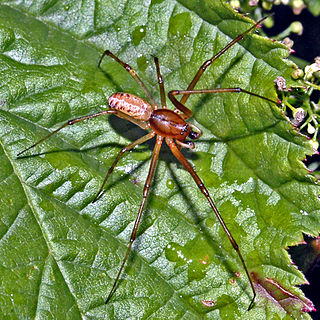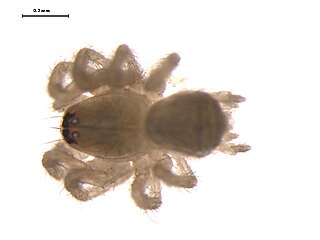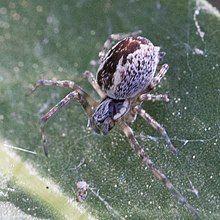
Dictynidae is a family of cribellate, hackled band-producing spiders first described by Octavius Pickard-Cambridge in 1871. Most build irregular webs on or near the ground, creating a tangle of silken fibers among several branches or stems of one plant.

Philoponella is a genus of uloborid spiders. Like all Uloboridae, these species have no venom.

Metacyrba is a genus of jumping spiders that was first described by Frederick Octavius Pickard-Cambridge in 1901. The name is combined from Ancient Greek μετά "after, beside" and the salticid genus Cyrba.

Phanias is a genus of jumping spiders that was first described by Frederick Octavius Pickard-Cambridge in 1901. They are similar to members of Marpissa, but have three pairs of spines beneath the first tibia.

Coneweb spiders (Diguetidae) are six-eyed haplogyne spiders that live in tangled space webs, fashioning a cone-like central retreat where they hide and lay eggs. It is a small family, containing only two genera split between a range in the Southwestern United States and Mexico and a range in South America. Members of the genus Diguetia usually build their webs in shrubs or between cactus pads. They have the same eye arrangement as the venomous recluse spiders.

Metepeira is a genus of orb-weaver spiders first described by F. O. Pickard-Cambridge in 1903. The name is derived from the Ancient Greek μετά and the obsolete genus name Epeira, denoting a genus similar to Epeira.
Melpomene is a genus of funnel weavers first described by O. Pickard-Cambridge in 1898. They range from southwestern U.S. to Panama and can grow up to 7 to 8.5 millimetres long. Roth and Brame noted that, with many undescribed species, the genus appears to be a catchall or "wastebasket taxon" for several unrelated species that may represent several genera.

Dictyna is a genus of cribellate araneomorph spiders in the family Dictynidae, and was first described by Carl Jakob Sundevall in 1833.

Frontinella is a genus of dwarf spiders that was first described by Frederick Octavius Pickard-Cambridge in 1902.

Eucteniza is a genus of trapdoor spiders in the family Euctenizidae containing at least 14 species occurring in Mexico and the southern United States. Species are distinguished by a softened rear portion of the carapace, and males possess large spines on the first two pairs of walking legs that are used to hold females during mating. Like other trapdoor spiders they create burrows with a hinged lid, from which they await passing insects and other arthropods to prey upon. Many species are known from only one or two localities, or from only male specimens. More species are expected to be discovered. Eucteniza is closely related to spiders of the genera Entychides and Neoapachella.

Linyphia is a genus of dwarf spiders that was first described by Pierre André Latreille in 1804. The name is Greek, and means "thread-weaver" or "linen maker".

Argenna is a genus of cribellate araneomorph spiders in the family Dictynidae, and was first described by Tamerlan Thorell in 1870.

Emblyna is a genus of cribellate araneomorph spiders in the family Dictynidae, and was first described by R. V. Chamberlin in 1948.

Lathys is a genus of cribellate araneomorph spiders in the family Dictynidae, and was first described by Eugène Simon in 1884. It is a replacement name for "Lethia" Menge, 1869 because that name was already in use as a synonym for a genus of moths.

Phantyna is a genus of cribellate araneomorph spiders in the family Dictynidae, and was first described by R. V. Chamberlin in 1948.

Neoantistea is a genus of dwarf sheet spiders that was first described by Willis J. Gertsch in 1934.
Metagonia is a genus of cellar spiders that was first described by Eugène Louis Simon in 1893.














